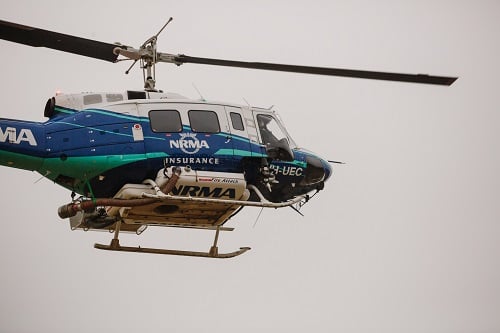

A recent newspaper cartoon depicted Rural Fire Service (RFS) volunteers standing shoulder-to-shoulder among the superheroes of the comic-book world – after all, not all heroes wear red or black capes. IAG’s NRMA Insurance has made a considerable effort to assist those heroes fighting against the raging bushfires in Australia, by providing the RFS with a helicopter to help protect homes and properties in the line of fire.
The NRMA helicopter has been deployed in the most fire ravaged areas in NSW, taking to the skies to help put out fires in rural Australia. NRMA spokesperson Luke Gallagher explained to Insurance Business the ways in which the helicopter is being used by the RFS to help fight the bushfires.
“We’ve had a partnership with the RFS for about 18 months now,” said Gallagher. “During this time the RFS have been using the helicopter and making decisions about how it is used.” Gallagher explained that over the last 40 days, the helicopter had spent approximately 300 hours in the air, providing water bombing assistance to the RFS team.
In addition to the round-the-clock assistance NRMA is providing for its customers in affected areas, Gallagher explained that the helicopter came about due to the insurer’s commitment to thinking of more ways to help those, customers or not, in need.
“The bushfires have been catastrophic, and we are always looking at new ways to explore how best to help out communities,” he said.
On top of this, the NRMA helicopter has been trialling the deployment of a brand-new fire retardant, called Fire Limit. It has never before been used in Australia, and NRMA is hoping that the retardant’s ground-breaking properties will help save even more homes and properties.
“Fire Limit is an organic, degradable, fire retardant and the first of its kind in Australia,” explained Gallagher. “The advantage of that is that it has been tested by international laboratories using internationally recognised methods – so we know it’s safe and fit for purpose.”
The advantage of the combination of the helicopter and new retardant is that it can be sprayed across all four walls of a burning home, as opposed to just being dropped from above as many fixed-wing aircraft currently do. “The NRMA helicopter and the usage of Fire Limit mean that it can be sprayed into more specific areas,” meaning that more of people’s homes and properties have a better chance of being saved.
It’s not just the skies that NRMA has taken to, the insurer has deployed four of its Major Events Rapid Response Vehicles (MERRV) to help bring specialist claims teams to the most rural fire-affected communities.
“Our MERRVs, as we call them, look similar to a mobile home, but come with full satellite capability to deliver mobile claims,” said Gallagher. “They are modern, air conditioned and there is desktop functionality to give our claims teams the right working environment to provide a full claims service.”
While the helicopter acts as an immediate fire fighter, the MERRVs are used to help those in the most fire affected rural communities start to rebuild their lives, bringing a sense of normality to a catastrophic event. The MERRVs can go to those communities affected, rather than them having to make a potentially long and arduous journey to a town or city.
“They can pull up a chair, have a cup of tea and lodge a claim,” said Gallagher. It seems that insurance help can take many forms in bringing much needed aid to the communities in need.
